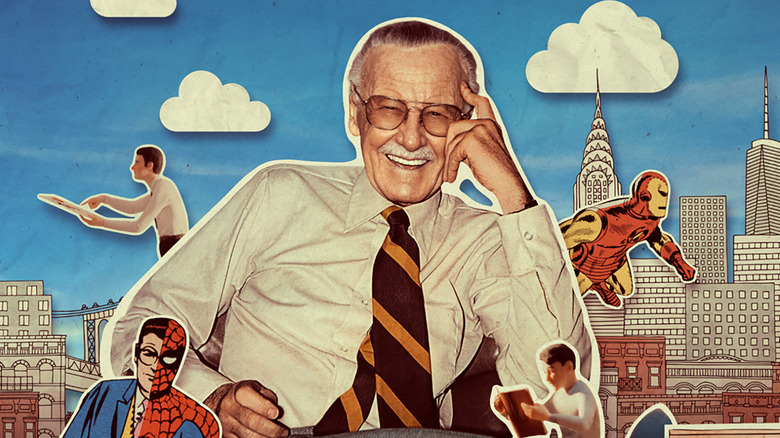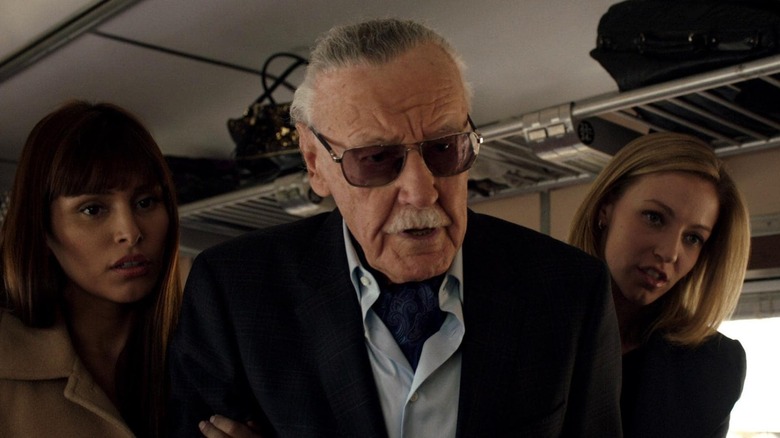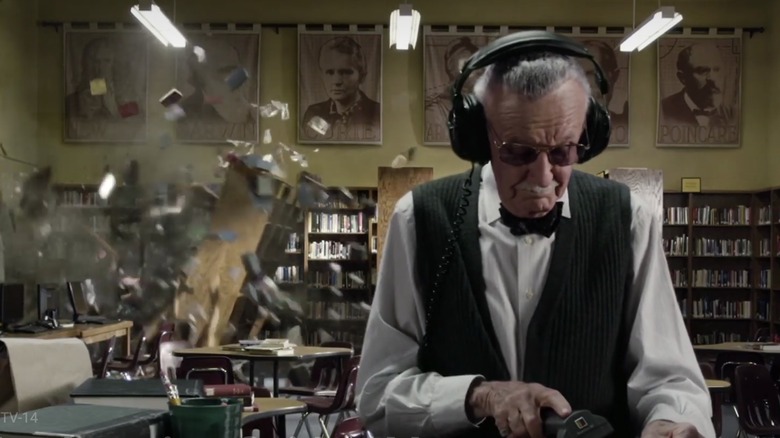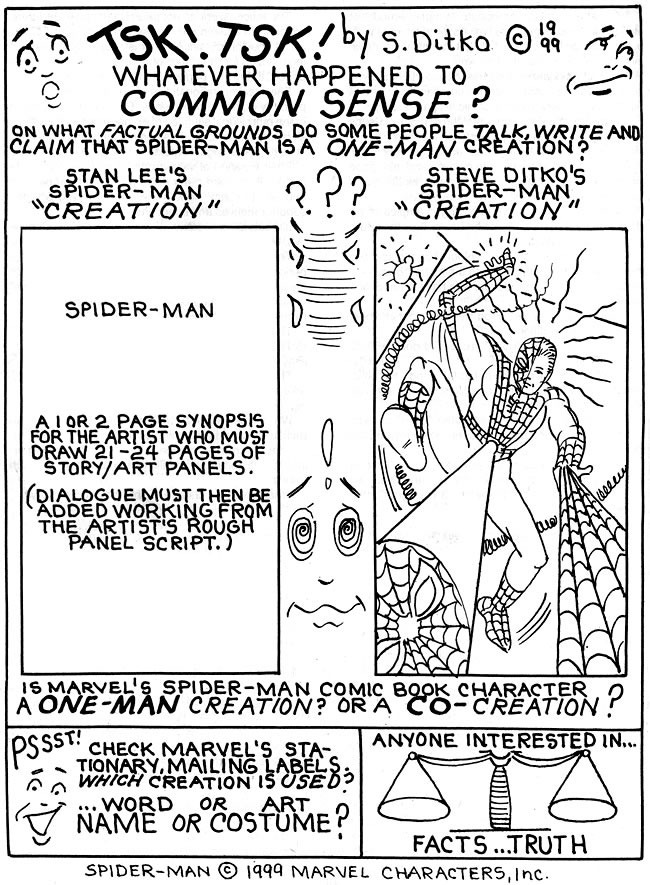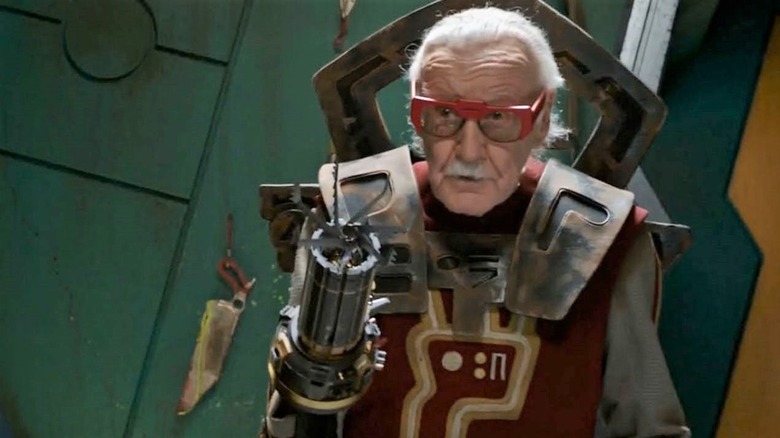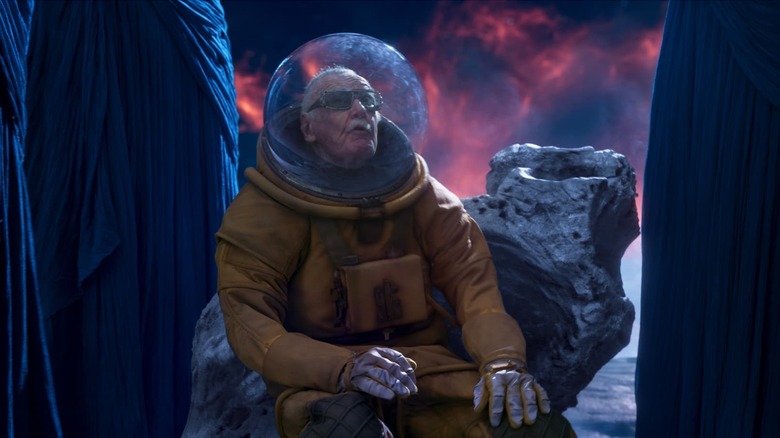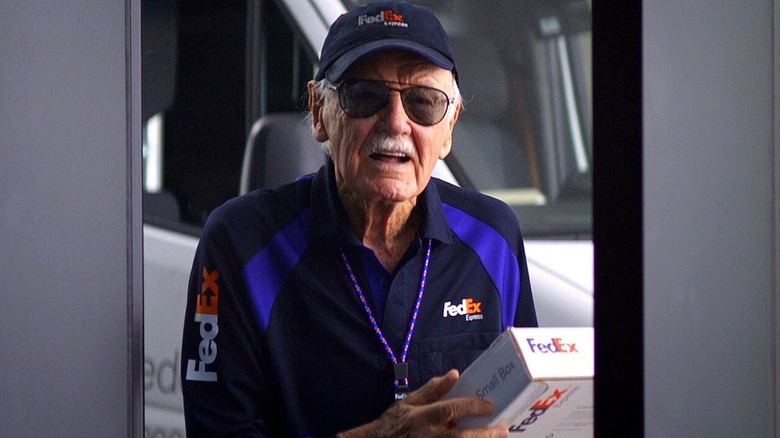Disney's Stan Lee Documentary Doesn't Tell The Whole Story Of Marvel Comics
The new biographical documentary "Stan Lee" was released to Disney+ on June 16, 2023. Directed by David Gelb, the doc tells the life story of the late Marvel Comics editor-in-chief. Do you know who isn't a fan of the film? Neal Kirby, son of Jack Kirby, who was a prolific comic book artist and Lee's credited co-creator on The Fantastic Four, Thor, Black Panther, and plenty more. In a statement shared by his daughter Jillian on Twitter, Neal Kirby called the documentary, "Stan Lee's greatest tribute to himself." Kirby reiterates past allegations made against Lee by various parties: that the image of Stan Lee as the creator of the Marvel Universe came about because he took undue credit for the work of others (such as Kirby's father) and had a "corporate megaphone" to win the public's hearts and minds.
As Kirby writes in his statement, proper creator credits at Marvel Comics remain controversial; it's a symptom of an industry built on the backs of freelancers. If you want a longer peek behind the curtain than this article can expend, I'd recommend the books "Marvel Comics: The Untold History" by Sean Howe or "True Believer: The Rise and Fall of Stan Lee" by Abraham Riesman. If you want a documentary that won't hold back on how cruel the comics industry can be, watch Sheena M. Joyce and Don Argott's "Batman & Bill," which chronicles the crusade to get Bill Finger a co-creator credit on Batman media.
Here, though, let's look at "Stan Lee" the documentary itself, what it says about the myth of Stan Lee, and why it is advantageous to Marvel and Disney to preserve that myth.
The ideas man
"Stan Lee" doesn't elide Jack Kirby or Steve Ditko (credited co-creator and original artist of both Spider-Man and Doctor Strange). Like in the Marvel Comics issues of the 1960s themselves, Kirby and Ditko are consistently credited as the artists who drew Lee's ideas. But their role has never been in dispute — the problem is the distribution of credit. The documentary always shows Marvel characters as originating with Lee. It's inferred that his comic creations stemmed from his childhood love of pulp novels and a recurring refrain is that, at Marvel, Lee was creating the kind of stories he wanted to read.
The documentary, narrated with cobbled-together audio of Lee's many media appearances, includes him recounting how he came up with the Fantastic Four as a superhero team after hearing about DC launching the Justice League; how he mixed together Frankenstein and Dr. Jekyll & Mr. Hyde to get the Hulk; how a fly on the wall inspired him to make a wallcrawling hero. The documentary even includes a clip from an interview with Lee by Larry King, where he claims he considered Jack Kirby to draw Spider-Man but chose Ditko instead because Kirby's characters looked too heroic, not "nebbish" like how Lee envisioned Peter Parker.
In other words, Lee had all the ideas, and the artists just executed his vision. This is how things would be recognized from a corporate perspective: Lee was on Marvel's staff (as a writer, editor, and art director), while Kirby and Ditko were just contractors. Spiritually and artistically, though? That's another story.
The Marvel Method
Part of this goes back to the "Marvel Method" of creating comics that Lee devised. He would come up with an idea for an issue (it could be as simple as "The Fantastic Four fight Doctor Doom"), the artist would draw 20 pages, then Lee would add in the dialogue. The documentary frames this as a triumph of collaboration and efficiency, which is exactly how Lee sold it. Lee is portrayed as an enthusiastic collaborator, who even acted out his ideas in his office during brainstorming sessions. However, the Marvel Method is the root of authorial disputes; artists had to design much of the story themselves, and Lee admits that Kirby and Ditko often added things to their art he'd never suggested.
As the doc recounts, Steve Ditko took umbrage with Stan Lee being described as the "creator of Spider-Man." Ditko felt that because he'd instilled Spider-Man with everything unique about him, he deserved credit as the creator. Lee argued that since he'd come up with the idea for Spider-Man, his "creator" description was earned. This dispute, and Ditko's resultant feelings of being unappreciated, financially or otherwise, is why he left Marvel and Spider-Man behind in 1966.
In 1999, Lee penned a letter saying he had "always considered Ditko the co-creator of Spider-Man." This didn't satisfy Ditko, who drew the following comic that neatly summarizes the dispute between himself and Lee:
Funky Flashman and the Fantastic Four feud
Some claim the Marvel Method embellishes Lee's role too much. In his statement, Neal Kirby asserts that his father was the principal creator of The Fantastic Four, citing their similarities to one of Kirby's other creations, the Challengers of the Unknown, and the fact that the Thing was named for Kirby's father Benjamin while the Invisible Woman was named after his daughter Susan. Alan Moore, one of the comic medium's greatest talents and the industry's greatest critics, has said that, from his meeting with Kirby and viewing of his original art, he is "inclined to believe [Kirby] created almost all of [the Marvel characters] by himself" and that Stan Lee's role was just prettying-up Kirby's dialogue suggestions.
In a 1990 interview with David Groth for The Comics Journal, Jack Kirby also described himself as the sole creator of the Fantastic Four and Thor, saying Lee was "essentially an office worker," not a storyteller like himself. Both Kirby and his wife Roz also claim they never saw the "detailed plot synopsis" for the Fantastic Four that Lee allegedly wrote. In 1991, a copy of what Lee claimed was his original synopsis ran in "Fantastic Four" issue #358.
Kirby, feeling swindled in the same way that Ditko had, jumped ship to DC in 1970. In his series "Mister Miracle," he caricatured Stan Lee as "Funky Flashman," a con artist living in a decrepit house he inherited from someone else. Lee would claim he offered Kirby the salaried position of art director, but Kirby declined. He did eventually return to Marvel, but it was once again as a freelancer.
Stan Lee: Marvel mascot
The documentary chronicles Lee and Ditko's falling out, and the reasons behind it. It also includes audio clipped from a 1987 radio interview with Kirby, where Lee calls in and the two spar over how much dialogue Lee actually contributed to the comics Kirby drew. It would've been journalistic malpractice to exclude these controversies, but the presentation of facts in "Stan Lee" ultimately condones Lee's interpretation of events: the house of Marvel was built on his idea and he was thus the original creator of its inhabitants. The reason why becomes clear as the doc wraps up.
Before Lee's death in 2018, he stayed in the public eye by cameoing in Marvel's theatrically-released movies (beforehand, he'd also shown up in some TV movies and cartoons). The tradition started in 2000's "X-Men" and his final cameo was in 2019's "Avengers: Endgame," filmed before his passing but released afterward. These cameos helped cement Lee in the public consciousness as the mascot of the Marvel universe. They were an evolution of his "Merry Marvel Marching Society" records or how he portrayed himself as the eccentric "Smiley" in the back letters of Marvel comic issues while he was editor-in-chief. Thanks to both his power at the office and his sense of showmanship, Lee was always successful at making sure people knew his name and making himself synonymous with Marvel.
On the other hand, Kirby died in 1994 before the Marvel movie boom, while Ditko (who also passed in 2018) was a media-shy recluse. While they are credited as co-creators in Marvel movies, they never had a public persona people could latch onto. This is the way Marvel, and now its parent company Disney, would prefer it. The Marvel Universe being accepted as the work of one genius means they don't have to traverse any slippery slopes about creators' rights.
Exploitation lives on
Surprise, surprise, comic creators are still generally contract workers, and their exploitation hasn't ended. In the 1970s, Jim Starlin created Thanos, Gamora, and Drax. Without him, the Marvel Cinematic Universe as it is wouldn't exist. And yet, Starlin initially received more compensation for "Batman V Superman" featuring his character KGBeast than he did his contributions to the MCU. Ed Brubaker, who brought Bucky Barnes back to life as the Winter Soldier, has admitted he felt "f***ed over" by how he's been excluded from his creation's financial success: "They didn't have a movie studio when I wrote that story."
If the Kirby or Ditko estates were compensated in proportion to the success of their relatives' work, that could open the door for other contracted comic writers/artists suing to get their fair share. That's why Gelb's "Stan Lee" ultimately doesn't dispute Lee's version of events; it ends with pictures of Lee, Kirby, and Ditko lined up beside each other, as Lee's protégé Roy Thomas narrates that these men wouldn't have been as successful without the other. Marvel Studios president Kevin Feige may praise Ditko and Kirby, but there's no documentary about their contributions to Marvel on Disney+.
"Stan Lee" is streaming now on Disney+.
